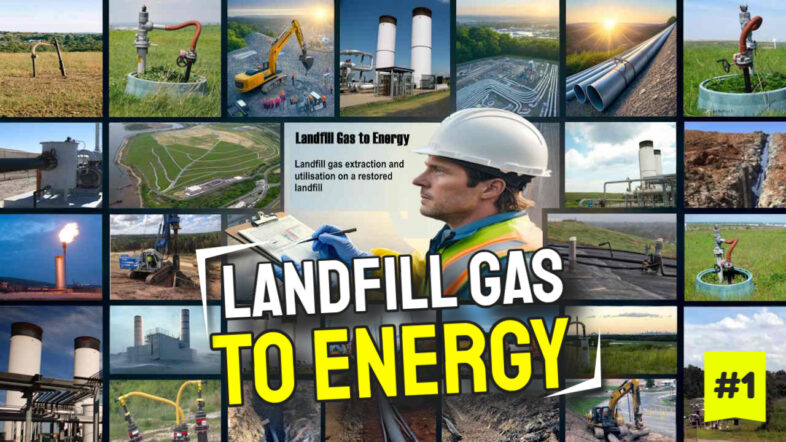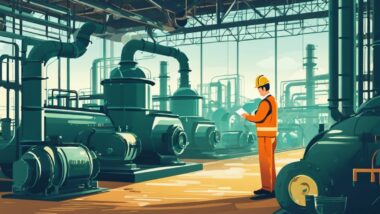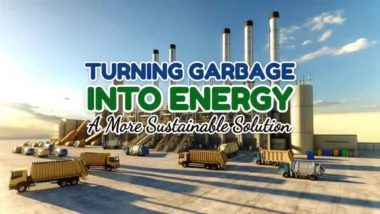Converting landfill gas to energy is an urgent global prerogative right now in the mid-2020s, as the rate of climate change seems to be accelerating, as the IPCC and recent COP meetings have stressed.
All waste now being landfilled really badly needs to be completed in discrete phases of filling with each annual completion covered as quickly as possible, and gas extraction to turn the landfill gas into energy as quickly and efficiently as possible.
It’s the most pressingly obvious win-win for the climate out there! If you’re worried about how much trash we throw away, you’re not alone. Landfills around the globe are a massive source of methane, the most potent gas that heats our planet. This article shows how turning landfill gas into energy can help fix that problem.
Let’s dive in and see how it works!
Key Takeaways
- Landfills produce a gas called landfill gas (LFG) that can be extracted from landfills and turned into renewable energy. This helps fight climate change by capturing methane, which is much more effective at warming the planet than CO2.
- Engineers use special systems with wells and pipes to collect the LFG from landfills. It’s then cleaned and upgraded to renewable natural gas (RNG) or used directly for electricity, heating buildings, or even fueling vehicles.
- About 70% of LFG projects generate electricity using technologies like internal combustion engines. They prevent methane from reaching the atmosphere and support our power grid.
- Renewable Natural Gas (RNG) produced from LFG is so similar to fossil natural gas as to be interchangeable but more eco-friendly. It can be used in various ways, including powering vehicles with compressed natural gas (CNG).
- These landfill gas energy projects greatly reduce greenhouse gases and cut down on using non-renewable resources like coal or oil. They also boost local economies by creating jobs and providing a sustainable source of clean energy for communities.
Understanding Landfill Gas
Landfills are not just piles of trash; they’re bubbling with gas. This gas, known as landfill gas (LFG), is a mix that we can turn into energy.
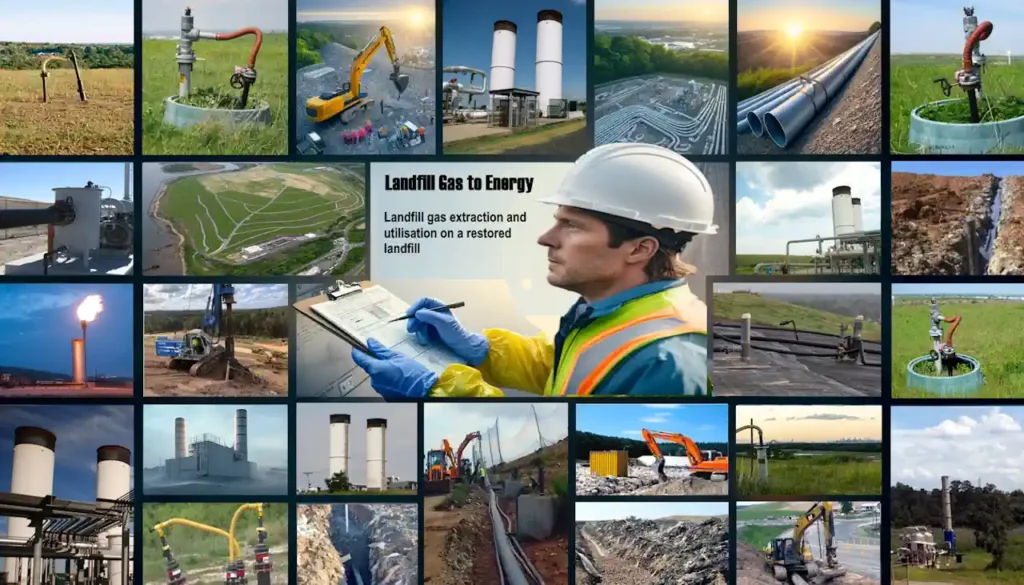
Methane Emissions from Landfills
Municipal solid waste (MSW) landfills release a lot of methane into the atmosphere. This gas is a byproduct of organic material breaking down. Methane traps heat way more effectively than CO2, making it a significant contributor to global warming.
With MSW landfills being the third-largest source of human-related methane emissions in the United States, they play a big role in climate change.
Capturing this methane presents an opportunity to turn a harmful emission into energy. Landfill gas (LFG) projects can grab 60 to 90 percent of this gas before it hits our skies. Turning landfill methane into electricity or renewable natural gas cuts down on these emissions and battles global climate change at its core.
This process not only helps clean up our air but also puts us on a path toward greener, renewable energy sources.
Collecting and Treating Landfill Gas
Landfills hide a valuable resource – gas. This gas can power homes and businesses if we collect and treat it right. Here’s how:
- Vertical Wells or Horizontal Trenches: The process starts with setting up a system to collect the landfill gas (LFG). Engineers drill vertical wells deep into the landfill or dig horizontal trenches. This step is crucial for capturing LFG before it escapes into the atmosphere. Horizontal trenches are filled with gas-permeable stone.
- A Network of Pipes: Once wells or trenches are in place, a network of pipes connects them. This system carries the collected gas to a central point for processing. It’s like gathering straws from all corners of a yard to direct rainwater to one barrel.
- The Flare Station: Before treatment and during gas engine downtime and maintenance, some LFG gets flared. Flaring burns off excess gas safely.
- Upgrading to Renewable Natural Gas (RNG): Now comes the makeover for LFG—upgrading it to RNG through treatment processes. Upgrading equipment, often using gas-selective membranes is used to remove carbon dioxide (CO2), water vapor, and other contaminants. The result of that purification step is a clean fuel that’s kinder to our planet.
- Compliance Checks: Treating LFG isn’t just about making RNG; it’s also about meeting guidelines from bodies like the U.S. Environmental Protection Agency (EPA). These checks ensure that the process respects both local regulations and global standards for clean air.
- Monitoring Systems in Place: Throughout this journey, monitoring systems work round-the-clock. They check for leaks in pipes, efficiency in gas collection, and purity levels after treatment. It’s this constant vigilance that keeps everything running smoothly.

Converting Landfill Gas to Energy
Transforming landfill gas into energy is a clever move. It turns waste problems into power solutions, lighting up homes and businesses.
Electricity Generation
Landfill gas (LFG) is not just waste; it’s a valuable resource for generating electricity. About 70% of LFG projects use internal combustion engines, gas turbines, and microturbines to turn this gas into power.
These technologies are efficient at converting methane, a potent greenhouse gas, into electricity that homes and businesses can use. By doing so, they prevent methane from reaching the atmosphere, where it can contribute to global warming.
Reciprocating engines are especially popular for LFG electricity applications because they’re effective and widely available. This process not only supports the grid with additional energy but also plays a crucial role in combating air pollution and offsetting fossil fuel use.
With every kilowatt-hour produced from landfill gas, we take a step towards cleaner air and a healthier planet. Now let’s explore how medium-Btu gas directly benefits various sectors beyond just lighting up our homes.
Direct Use of Medium-Btu Gas
Medium-Btu gas from landfills is a game-changer for some industries. Factories and plants can use this gas instead of other fuels to make steam or hot water. This switch helps them cut down on harmful emissions and rely less on fossil fuels.
It’s an efficient way to reuse what would otherwise pollute the air.
About 16 percent of operational projects tap directly into landfill gas (LFG) for thermal applications, like heating buildings or industrial processes. This not only offsets the need for conventional energy sources but also puts to good use gases that could harm our planet.
By opting for this method, businesses play a critical role in tackling global warming while saving on energy costs.

Renewable Natural Gas
Moving from the direct use of medium-Btu gas, another innovative way to harness landfill emissions is through the production of Renewable Natural Gas (RNG). This clean energy resource comes from upgrading landfill gas (LFG), which involves various treatment processes.
The goal here is to transform it into a higher-quality fuel that’s similar to fossil natural gas but far greener. RNG can power vehicles as compressed natural gas (CNG), feed into local utility pipelines, or even generate electricity and heat for homes and businesses.
The Environmental Protection Agency’s Landfill Methane Outreach Program (LMOP) has been pivotal since 1994, aiding landfill operators in capturing and using LFG effectively. By doing so, they not only comply with regulations under the Clean Air Act aimed at reducing hazardous air pollutants but also contribute significantly toward mitigating climate change impacts.
State rules around these projects can vary, with some states enforcing stricter measures than federal laws demand, underscoring the importance of tailored approaches in different regions.
Through RNG projects, we see a dual benefit: cutting down on harmful greenhouse gases while simultaneously creating a versatile, sustainable fuel source for multiple applications.
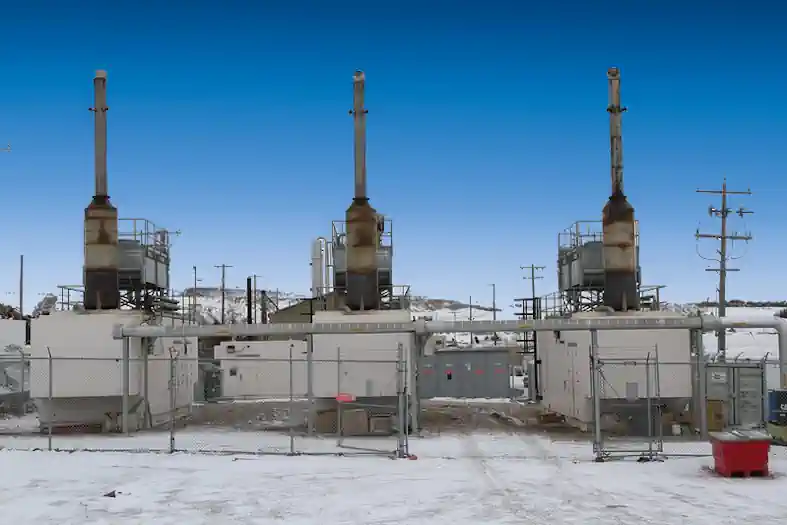
The Impact of Landfill Gas Energy Projects
Landfill gas energy projects light up more than just homes—they ignite change across communities and the environment. They turn waste issues into power solutions, making a cleaner world seem not so far out of reach.
Reducing Greenhouse Gas Emissions
Turning landfill gas into energy has a big impact on cutting down greenhouse gases. Methane, coming from landfills, is a powerful climate pollutant. It’s about 28 to 36 times more effective at trapping heat in the atmosphere than carbon dioxide over a 100-year period.
By capturing it and transforming it into energy, we prevent this potent gas from contributing to global warming. LFG energy projects can capture up to 90 percent of methane emissions from landfills.
This action significantly reduces the amount of harmful greenhouse gases entering our atmosphere.
These projects not only cut down on methane but also contribute to cleaner air by reducing pollutants like particulate matter and smog-causing compounds. By turning waste into power, we’re taking steps towards a low-carbon future—decreasing reliance on fossil fuels and paving the way for renewable sources like biogas and biomethane.
Each step taken towards utilizing landfill gas as an energy source represents progress in mitigating climate change effects while promoting sustainable resource use.

Offsetting Use of Non-Renewable Resources
Cutting down on greenhouse gas emissions goes hand in hand with less reliance on non-renewable resources. Landfill gas to energy (LFGTE) projects shine here, turning waste into a powerful ally against the use of fossil fuels.
These endeavors capture methane—a short-lived climate pollutant—and convert it into renewable fuel, electricity, or heat for communities and businesses. This switch promotes a lower carbon footprint and supports U.S. renewable fuel standards.
LFGTE not only taps into an otherwise overlooked energy resource but also steers us away from oil, coal, and natural gas dependencies. Using landfill-derived biogas as a substitute for these conventional fuels drives down the demand for non-renewables.
Moreover, this approach aligns with global efforts to mitigate climate change by promoting cleaner air and reducing acid rain precursors. Every tonne of methane repurposed symbolizes progress towards a more sustainable and less polluting energy framework, encouraging resource recovery over disposal.
Contributing to the Community and Economy
Landfill gas (LFG) energy projects are more than just a clever use of waste; they’re powerful drivers for local economies. By capturing methane—a potent greenhouse gas—from landfills and converting it into energy, these projects generate revenue and create jobs.
Imagine this: a 3 MW electricity project from LFG can directly create five construction jobs. But the impact doesn’t stop there—it indirectly boosts economic development, leading to another 20 to 26 jobs.
These initiatives also play a crucial role in preserving our environment while fueling our economy. They offset the use of non-renewable resources, thereby reducing our carbon footprint.
With every landfill converted into an energy source, communities take a step towards cleaner air and sustainable growth. The production tax credit aids in this transition, providing financial incentives that encourage further investment in green technology—resulting in healthier communities supported by renewable energy sectors that promise longevity and resilience amidst changing climates.
Conclusion
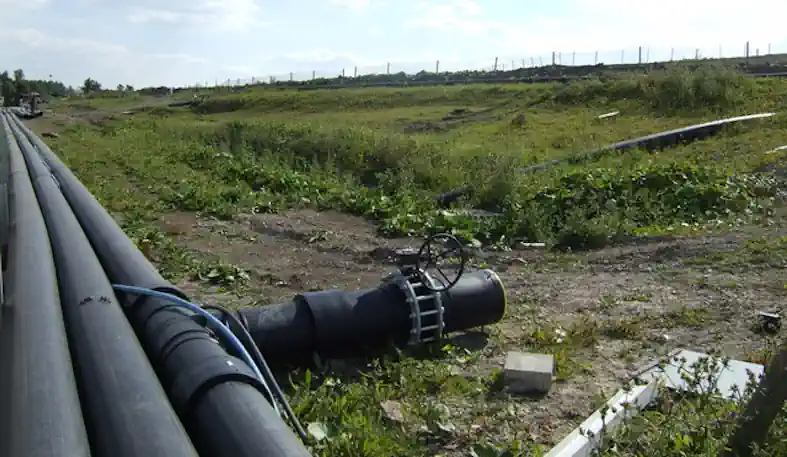
Turning trash into treasure, landfill gas to energy projects are game changers. They fight climate change by capturing harmful methane and turning it into clean energy. This process not only cleans up our air but also powers our homes and businesses.
Imagine a world where waste helps fuel the future — that’s the power of innovative thinking and action. Together, we’re making strides toward a more sustainable planet, one landfill at a time.
FAQs
1. What exactly is “landfill gas to energy”?
Landfill gas to energy is a method where we capture methane from landfills and turn it into power for homes and businesses. It’s pretty cool, actually—taking something harmful like methane, which can heat up our planet, and using it to keep the lights on!
2. How does this process help our planet?
By capturing methane from landfills and using it as an energy source, we’re hitting two birds with one stone—reducing greenhouse gases that warm the Earth and creating renewable energy. This means less pollution and more clean air for us.
3. Can landfill gas really be turned into electricity?
Yes! With technology like anaerobic digesters and power plants specifically designed for this purpose, landfill gas is transformed into electricity that powers everything from factories to your home TV. Imagine turning trash into treasure!
4. Why don’t we burn all landfill gas instead of letting it harm the environment?
While burning or “flaring” the gas does reduce its impact, not all of it can be captured due to technical limits or costs. However, efforts are constantly being made through programs like LMOP (Landfill Methane Outreach Program) to improve how much gas we can safely use for energy.
5. What about other uses? Is electricity the only thing we get out of landfill gas?
Not at all! Landfill gas doesn’t just light up homes—it also fuels vehicles or becomes heat in combined heat and power systems (CHP), showing off its versatility as a low-carbon fuel option.
6. Are there any challenges with turning landfill gas into energy?
Sure, there are challenges such as removing impurities like hydrogen sulfide from the methane so engines don’t get damaged; plus ensuring local communities support these projects by understanding their safety measures—like complying with strict rules under acts like RCRA (Resource Conservation and Recovery Act) And always striving towards solutions that benefit both people and our planet makes tackling these hurdles well worth it.
Text in panel


